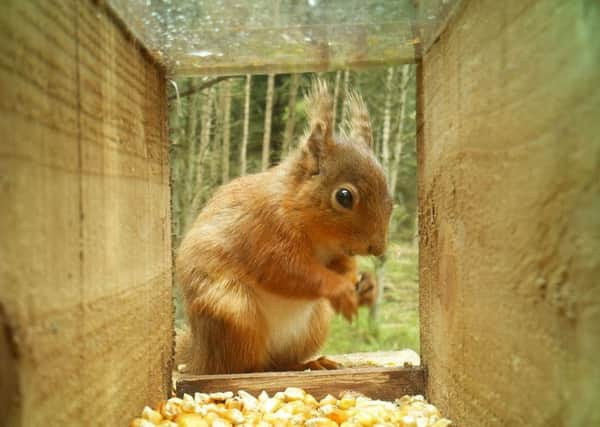Red squirrel sees off grey invaders in Aberdeenshire wood


Now, in woodland near Aberdeen, “team red” appears to have won this fight for survival.
Recent results from feeder boxes and camera traps in Countesswells and Foggieton woods have indicated that the smaller red squirrel is dominating these forests once again.
Advertisement
Hide AdAdvertisement
Hide AdForest Enterprise Scotland (FES) and Saving Scotland’s Red Squirrels (SSRS) has concluded that the red squirrel population is now on the rise in this corner of north east - and that the woods are free from the non-native greys.
It comes after analysis of hairs collected from feeding boxes confirmed that no greys have been recorded in the woods for the last two years.
Philippa Murphy, Environment Manager for the FES team in the area, said: “We put some sticky tape on the feeder boxes to collect hairs and these, once analysed, showed that the number of red squirrels recorded in these woodlands are increasing year on year, suggesting more and more red squirrels are taking advantage of the free treats on offer.
“But the best news is that we’ve got no trace of grey squirrels, which tend to drive reds away from local habitats.
Advertisement
Hide AdAdvertisement
Hide Ad“It’s a great pat on the back for all the hard work that has been put into this project by all the SSRS partners.
“It’s a great reward for us too – it’s like getting a thumbs up from the red squirrels for our sensitive management of the forests around Aberdeen.”
As well as feeder boxes, red squirrels have been encouraged into the woods by reducing the number of open clearings in the forest with the species preferring a continuous canopy to move around in.
Planting more trees favoured by the reds, such as conifers, can also increase numbers.
Advertisement
Hide AdAdvertisement
Hide AdThe results at Countesswells and Foggieton follow an increase in reports of red squirrels in parts of Aberdeen where only greys have been noted decades.
Earlier this year, the first red squirrel in seven years was trapped - and released - in Seaton Park with reports of other red activity along the river Dee, the river Don, around the University of Aberdeen, and in the urban areas east of Hazlehead Park.
There are an estimated 125,000 red squirrels in Scotland - around three quarters of the total population in the UK.
Grey squirrels were introduced to Scotland from the USA and Canada in the late 19th century and have dominated the squirrel population in southern and central Scotland.
Advertisement
Hide AdAdvertisement
Hide AdThe spread of the grey is considered the main threat to the red squirrel population given they can compete more successfully for food and habitat.
Another threat is the squirrelpox virus which research suggests was introduced to the UK with grey squirrels but who have now evolved to show no outward symptoms of the infection.
In reds, the disease quickly results in severe skin lesions on the hands, face and groin with the condition usually causing death within 15 days of infection.
Matt Nuttall, SSRS Conservation Officer, said the organisation was “extremely pleased” with the results of the work at Countesswells and Foggieton to limit the grey squirrel population.
Advertisement
Hide AdAdvertisement
Hide AdHe added: “It demonstrates that the hard work of all the project partners, our volunteers, and members of the public over several years has had a real positive impact on red squirrels.”
Work will continued to turn the forests into red squirrel “strongholds” with the conservation work partly supported by mitigation funds from the new Aberdeen by-pass.
